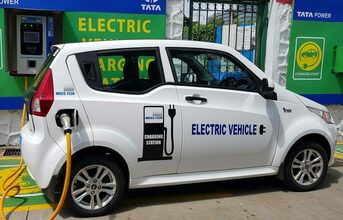
In line with expectations, the automobile sector, especially commercial vehicles (CV) would continue to reap the benefits of the Government's continued thrust on infrastructure development and capital expenditure across sectors. The government's Gati Shakti programme, encompassing thrust on seven different engines of growth including roads, railways, and multi-modal logistics infrastructure augurs well the demand for CVs, especially tipper trucks.
Shamsher Dewan, Vice President & Group Head - Corporate Ratings, ICRA Ltd said, "The Government's effort to mobilise funds through multiple avenues, especially Sovereign Green Bonds besides addressing the inherent bottlenecks to ensure faster execution of infrastructure projects by construction companies will be critical for uplifting the sentiments of the construction equipment segment, including tipper trucks."
The medium and heavy commercial vehicle (M&HCV) truck segment, which has witnessed sharp demand contraction over the past two years, will get support from the increased allocation towards the infrastructure sector. Further, the Government's focus on climate change and clean mobility through plans to introduce battery swapping policy and standardization of charging infrastructure norms also augur well towards enhancing the penetration of electric buses in key cities.
According to Unsoo Kim, MD, Hyundai Motors India Ltd, the government's strong approach towards accelerating infrastructure development, sustainability with digitalisation in every sphere of business will give a strong impetus to the overall economy while empowering consumerism in India. The vision for clean mobility creating an electric vehicle ecosystem is a positive indicator for the auto industry and its large supply chain. The forward-looking budget will lay a modular economic structure for every section of business and society in India.
For Kamal Bali, President & MD, Volvo Group, India it was a progressive, thoughtful, imaginative, and growth-oriented budget that touches all socio-economic segments while embracing technology and modern tools of governance. "The budget has rightly allocated the highest ever Capex of $100 billion (Rs 7.5 lac crore), up 34 per cent over the last year, aimed at creating and improving our logistics infrastructure through PM Gati Shakti NMP, as well as social sectors of health, education, women, housing and the needs of our 112 aspirational districts."
Electric Vehicles
The government focus on promoting electric vehicles, as a means of transportation in the country, was reiterated in the budget. In addition to existing financial incentives under the FAME-II scheme to boost demand and the PLI Schemes for ACC and auto segment focused on EVs and other alternative energy technologies, the Finance minister in the budget announced plans to implement a battery swapping policy and formalise interoperability standards. If implemented efficiently, the same is likely to go a long way in reducing range anxiety about EV adoption while also aiding economies of scale in battery production.
"Considering, the battery swapping policy one of the initiatives in the Budget for the auto industry, we feel the policy as being a sincere advocate of EVs as last-mile mobility solutions. A larger battery swapping infrastructure will help enhance EV infrastructure and should propel the adoption of EVs. We are glad that the government is encouraged to create sustainable and innovative business models for battery and energy as a service, improving the efficiency in the EV ecosystem," opines Diego Graffi, Chairman and MD, Piaggio Vehicles Pvt. Ltd.
The Finance minister also announced plans to further the push for EV penetration in public transport and create special mobility zones for EVs, which should also spur EV demand. In addition, the inclusion of energy storage in the harmonised list of Infrastructure will facilitate cheaper financing availability to EV battery makers.
Welcoming the battery swapping policy, Sohinder Gill, Director General, Society of Manufacturers of Electric Vehicles (SMEV), feels that it will help to develop EV infrastructure and increase the use of EVs in public transportation. "It would motivate businesses engaged in delivery and ride aggregation businesses to incorporate EVs into their fleet and will create new avenues for companies to venture into the business of battery swapping," he added. Additionally, creating special clean zones will further accelerate the adoption of EVs and spread awareness amongst the citizens. The move will benefit the whole segment, i.e E2W, E3W, E-cars, and buses.
For Chetan Maini, Chairman & Co-founder of SUN Mobility, it would be great to see the government addressing key points around how customers can access subsidies (currently available for EVs), range per charge criteria (as swap batteries, by definition, are smaller and with less range) and GST for swapping services in line with EVs.
Logistics Sector
PM Gati Shakti Masterplan is expected to provide much-needed impetus to the logistics sector, by enabling higher integration for all modes of transport, thereby improving India's cost competitiveness globally. It is a transformative approach towards facilitating faster movement of goods and includes seven engines i.e. roads, railways, ports, airports, mass transport, waterways and logistics infrastructure. The multi-modal connectivity provides seamless connectivity for the movement of goods and services from one mode of transport to another. It is also expected to reduce time and facilitate the last mile connectivity of infrastructure through Rs 20,000 crore financed by the government to speed up this project.
"The PM Gati Shakti project is revolutionary as this focuses on multi-modal logistic parks and Unified Logistics Interface Platforms, we believe that it will help in reconciling supply chain constraints and make them more robust," adds Diego Graffi.
To strengthen the road logistics and supply chain, expressways are expected to be extended by more than 25000 km and four multi-modal national parks contracts will be awarded in FY2023. Further, eight remote connectivity roadway projects for over 60 km are to be awarded in FY2022 and FY2023 through PPP mode to enable trade facilitation as well as job creation. Under the Gati Shakti Plan, Railway logistics will also get a boost with the development of 100 Cargo Terminals in the next few years, and 400 new generation Vande Bharat trains. It also aims at developing efficient logistics for small farmers & enterprises and the 'One station, one product' concept facilitating the supply chain of local products. Further, the focus is also towards developing a unified logistics interface platform to automate and digitalise logistics paperwork. Unified Logistics Interface Platform will enable efficient movement of goods, assist Just-In-Time inventory management, reduce logistics costs and time, and eliminate tedious documentation.
Automotive
The Government's continued focus on rural development and farmer welfare in the budget augurs well to uplift rural sentiments, and thereby remains positive for the tractor and two-wheeler segment. The allocation of Rs. 20,000 crore for road infrastructure projects, is likely to lead to spillover demand for commercial vehicles and would be a positive for the segment. The plans to implement a battery swapping policy and formalize interoperability standards, if implemented efficiently, are likely to go a long way in reducing range anxiety with regards to EV adoption while also aiding economies of scale in battery production. The Finance minister also announced plans to further the push for EV penetration in public transport and create special mobility zones for EVs, which should also spur EV demand.





































